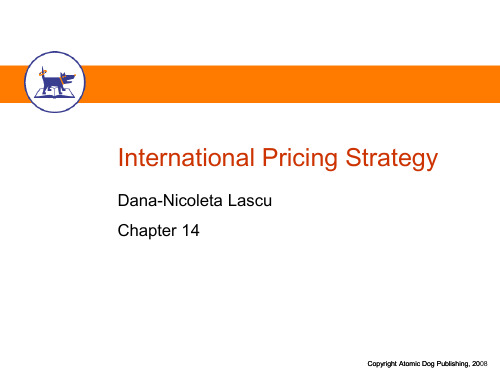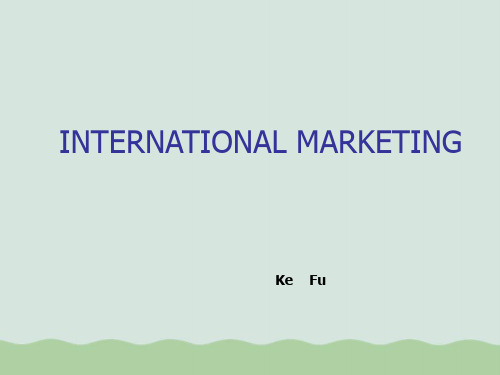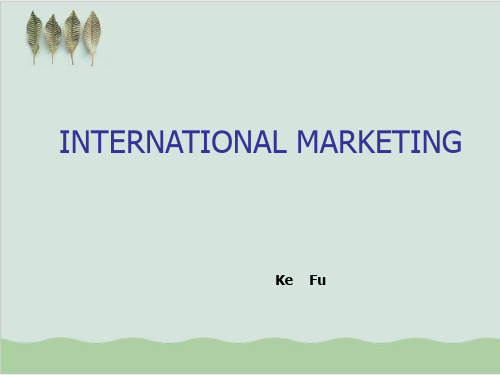英文课件-国际市场营销-chapter-14
合集下载
International Marketing 国际市场营销 课件

The existence of lucrative markets in foreign countries Saturated ( 饱 和 的 ) markets in the home country Response to incoming competitive activity
Further reasons for firms becoming involved in international marketing (1)Today, new product development typically requires so much expenditure that in many cases firms intending to introduce new products must adopt an international perspective. (2)The higher turnover derived from international sales might enable a firm to initiate new product research and development that in the long term will give it a competitive edge. (3)Corporate plans can be anchored (v. 抛 锚 、 锚 定 ) against a wider range of (international) opportunities.
亚洲: 欧洲: 非洲: 拉丁美洲: 北美洲: 大洋洲: 南极洲: 大西洋: 太平洋: 印度洋: 北冰洋:
Asia Europe Africa Latin America/South America North America Oceania Antarctica Atlantic Ocean Pacific Ocean Indian Ocean Arctic Ocean
国际市场营销学Lascu_Chapter14

•
Copyright Atomic Dog Publishing, 2008
Pricing Decisions and Procedures
• Pricing decisions are affected by a number of factors:
•
Production Facilities:
•
•
•
Ability to Keep Track of Costs:
•
Copyright Atomic Dog Publishing, 2008
Environmental-Related Challenges and Pricing Decisions: The Competitive Environment
• Involves selling products below cost to get rid of excess inventory or to undermine competition. In other examples, a foreign company may impose high prices on the products it sells in the home market, where it has a monopoly status as a result of import barriers; the company can then use those high profits to sell at much lower prices in foreign markets in order to build market share and drive out competitors.
• Competition:
“市场营销”讲义(英文PPT 273页)

Economic Environment
Income Distribution
Subsistence economies Raw-material-exporting economies
Industrializing economies Industrial economies
Savings, Debt, & Credit Availability
Objectives
Course Organization Tasks of Marketing Major Concepts & Tools of Marketing Marketplace Orientations Marketing’s Responses to New
Challenges
Macroenvironmental Forces
World trade enablers Asian economic power Rise of trade blocs International monetary crises Use of barter & countertrade Move towards market economies “Global” lifestyles
Simple Marketing System
Communication
Industry (a collection
of sellers)
Goods/services Money
Market (a collection
of Buyers)
Information
Company Orientations Towards the Marketplace
国际市场营销双语-精品.ppt

国际市场营销学
2
Marketing Promotion
国际市场营销学
3
内容简介 Learning Objectives
1. The changing face of U.S. business 2. The scope of the international marketing task
3. The increasing importance of global awareness
风险大, 难度大 Higher Risk and More Difficulties
国际市场营销学
9
1.2 国际市场营销与国际贸易
International Marketing & International Trade
国际贸易: 国家之间有形产品与无形服务的交换活动
Exchange of the visible products and invisible services among the nations 国与国之间分工的结果
Outcome of the International Labor Division
国际市场营销学
10
国际贸易与国际营销的共同点
What are in common for the both?
经营活动的目的:获取利润
Business Purpose: Earning profit 交换对象:商品和劳务
Marketing and International Marketing
Marketing is a social and managerial process by which individuals and groups obtain what they need and wue with others.
国际市场营销英文版PPT课件

Sociocultural Environment
• Sociocultural environmrnt 1) high persistence core cultural
values 2) existence of subcultures 3) shift of secondary cultural values through time
4
Economic Environment
I The economic environment for marketing comprises the overall economy
II It includes: Business cycles Spending patterns Consumer income issues
• It provides important opportunities to improve customer value
Prosperity production employment demand
Recession production employment demand
Recovery production employment demand
• Consumer Income It influences whether or not consumers 6
5
• Business cycles and Spending patterns Spending patterns are linked to the
business cycle. The level of business activity that moves from prosperity to recession, to recovery.
国际市场营销学培训讲义(英文版)PPT(共22页)

从“海尔中国造”到“海尔世 界造”
海尔相信本土化制造是海尔国际化道路上关键的一步。1996年, 海尔在印尼设立了第一家海外工厂,到2002年海尔已在全球设立 了十余家工厂,这些工厂每年生产上百种产品,这些产品大部分 都在当时销售。 世界跨国公司大多选择劳力成本低的地区开设工厂。当1999年海 尔在美国设厂时,有一家业界权威杂志驻美国记者立即对海尔的 做法提出质疑:传诵国内劳动力成本低的优势,到人力成本昂贵, 市场饱和的欧美投资建厂,海尔是否明智? 试和你的小组成员就以下问题展开讨论:
- The attractiveness of International market
- The saturation of domestic market needs and intensive market competition
- (be continue)
The scope and challenge of International Marketing
Case analysis
2008年1月1日,中国运动品牌老大李宁将其触角伸向了美国耐克总部 所在地的波特兰,建立第一个海外鞋产品研发中心。但许多人不知道的 是,李宁的第一家海外直营店其实早于两年半前在荷兰开张了。
2007 年,李宁公司与一家荷兰经销商签署合同,在南部的马斯特里 赫特市开设了一家李宁旗舰店。这也是李宁的“海外第一店”。选择马 斯特里赫特,而非阿姆斯特丹,主要考虑到马城位于德国和比利时的边 境上,在那个区域又是最富裕的。李宁想通过马城特殊的地理位置来渗 入周边地区,以此作为跳板,间接深入欧洲的三大市场:英国、法国、 德国。李宁认为,荷兰市场与英、法、德市场有许多共通性,其规模又 小得恰到好处,正适合用来作为实验基地。
市场营销学第14章(英文)课件

Integrated marketing communications is the integration by the company of its communication channels to deliver a clear, consistent, and compelling message about the organization and its brands
• Broadcast • Print • Internet • Outdoor
市场营销学第14章(英文)
The Promotion Mix
Major Promotion Tools
Sales promotion is the short-term incentives to encourage the purchase or sale of a product or service
市场营销学第14章(英文)
The Promotion Mix
Major Promotion Tools
市场营销学第14章(英文)
The Promotion Mix
Major Promotion Tools
Advertising is any paid form of non-personal presentation and promotion of ideas, goods, or services by an identified sponsor
• Catalog • Telemarketing • Kiosks
市场营销学第14章(英文)
Integrated Marketing Communications
The New Marketing Communications Landscape
• Broadcast • Print • Internet • Outdoor
市场营销学第14章(英文)
The Promotion Mix
Major Promotion Tools
Sales promotion is the short-term incentives to encourage the purchase or sale of a product or service
市场营销学第14章(英文)
The Promotion Mix
Major Promotion Tools
市场营销学第14章(英文)
The Promotion Mix
Major Promotion Tools
Advertising is any paid form of non-personal presentation and promotion of ideas, goods, or services by an identified sponsor
• Catalog • Telemarketing • Kiosks
市场营销学第14章(英文)
Integrated Marketing Communications
The New Marketing Communications Landscape
国际市场营销学培训讲义(英文版)PPT课件( 22页)

Marketing Mix
4CS
Product customer wants and needs
Price
customer cost
Promotion customer communication
Place
customer convenience
6PS
----Political ----Public relation 10PS ----Probing ---Partition ---Prioritizing ---position
- To take advantages of the regulations and polices of domestic and foreign market - To acquire resources. - To avoid risk - To expand product life cycle
- The attractiveness of International market
- The saturation of domestic market needs and intensive market competition
- (be continue)
The scope and challenge of International Marketing
International corporations…. These companies’ business were located all around
the world….. More and more companies engage in International
marketing….. See next page Let’s try to think some Chinese International companies…. again, try to think about some foreign-owned Chinese companies….
20国际营销 英文版 课件 (14)

14-3
14-4
Demand in Global B2B Markets
▪ Three factors seem to affect the demand in international industrial markets differently than in consumer markets.
14-6
14-7
Stages of Economic Development
1 Traditional society
2 Preconditions
for takeoff
3 Takeoff
4 Drive to maturity
5 Age of mass consumption
The most important industrial demand will be associated with natural resources extraction
14-2
B2B Products in International Markets
• Industrial products (business-to-business) constitute a large part of global marketing
• The issues of standardization versus adaptation have less relevance to marketing industrial goods than consumer goods because there are more similarities in marketing products and services to businesses across country markets than there are differences.
14-4
Demand in Global B2B Markets
▪ Three factors seem to affect the demand in international industrial markets differently than in consumer markets.
14-6
14-7
Stages of Economic Development
1 Traditional society
2 Preconditions
for takeoff
3 Takeoff
4 Drive to maturity
5 Age of mass consumption
The most important industrial demand will be associated with natural resources extraction
14-2
B2B Products in International Markets
• Industrial products (business-to-business) constitute a large part of global marketing
• The issues of standardization versus adaptation have less relevance to marketing industrial goods than consumer goods because there are more similarities in marketing products and services to businesses across country markets than there are differences.
国际市场营销学课件

案例:股票和eBay
• 个人在线拍卖网站eBay在美国获得巨大成功,
但在法国和日本都遇到了阻力
• 在股票投资方面,日本只有9%家庭在股市直
接投资,法国的比例约为12%,而美国则有
50%家庭拥有股票
– 以上现象不难从日、法、美等国 的文化价值观差异找到原因
用文化价值观解释消费者行为
• 由美国的个人主义指数(IDV)91、日本46、法国
国际市场调研
国际市场细分 与目标市场确定 进入国际市场的战略决策 产品和服务的调整
第二章 国际市场营销文化环 境
Chapter Two International Marketing Culture Environment
Culture just different, not right or wrong, better or worse
常用网站:
(1) 案例库网 (2) 国际营销传播网 (3) 中国营销传播网 (4) 中国市场营销管理网 (5) 经济观察报网 (6) 中国经营报网
“市场营销是为创造达到个人和机构 目标的交换,而规划和实施理念、产品和服务构思、 定价、促销和配销的过程。”
一、What is Marketing?
二、营销观念的演变
营销的思想变化过程:
ຫໍສະໝຸດ 生产导向——“我生产什么,就卖什么” ; 产品导向——“酒好不怕巷子深”; 推销导向——“我卖什么,就让你买什么” ; 营销导向——“市场需要什么,就生产什么”; 社会营销导向——营销导向必须兼顾社会整体 利益和顾客长远利益。
看待市场的视野 本地化 市场营销方案 营销人员要求 整体一致 技能
国际营销环境
国外环境 (不可控因素) 政治 法律 经济 形势 定价
[精选]国际市场营销学培训讲义英文版
![[精选]国际市场营销学培训讲义英文版](https://img.taocdn.com/s3/m/42479c3153d380eb6294dd88d0d233d4b14e3f00.png)
The scope and challenge of International Marketing
starting point focus means endsSelling factory products selling profit and through promotion sales volumeMarketing target customer integrated profit market needs marketing through and wants customer satisfaction
The scope and challenge of International Marketing
Why do companies engage in International Marketing? - To increase their profit by increasing total revenue or decreasing the cost of goods. - The attractiveness of International market - The saturation of domestic market needs and intensive market competition - (be continue)
and through摩根,英联,达能与蒙牛Political-试和你的小组成员就以下问题展开讨论:19:20:3719:20:3719:2010/30/2022 7:20:37 PM2008年1月1日,中国运动品牌老大李宁将其触角伸向了美国耐克总部所在地的波特兰,建立第一个海外鞋产品研发中心。11、以我独沈久,愧君相见频。Political-海尔相信本土化制造是海尔国际化道路上关键的一步。世界跨国公司大多选择劳力成本低的地区开设工厂。在马城旗舰店开张之前,两位荷兰企业家曾多次上门拜访李宁北京总部,试图说服李宁与他们联手,共同打拼欧洲市场。市场营销学中4P指的是什么? 4C呢?and throughProduct– standaliation or adaptation?.15、楚塞三湘接,荆门九派通。
英文国际市场营销chapter-14ppt课件

• A company’s global pricing policy may make or break its overseas expansion efforts (due to foreign exchange complications)
• Firms also face significant challenges in coordinating (standardizing or adapting) their pricing strategies across various countries they operate in
Chapter 14
Pricing for International Markets
Chapter Learning Objectives
1. Components of pricing as competitive tools in international marketing
2. The pricing pitfalls directly related to international marketing
6. The mechanics of price quotations
Introduction
• Pricing strategy forms another cornerstone of a global marketing program–it represents one of the most critical and complex issues in global marketing (due to economic, financial, and mathematical implications)
• Parallel imports develop when importers buy products from distributors in one country and sell them in another to distributors who are not part of the manufacturer’s regular distribution system
• Firms also face significant challenges in coordinating (standardizing or adapting) their pricing strategies across various countries they operate in
Chapter 14
Pricing for International Markets
Chapter Learning Objectives
1. Components of pricing as competitive tools in international marketing
2. The pricing pitfalls directly related to international marketing
6. The mechanics of price quotations
Introduction
• Pricing strategy forms another cornerstone of a global marketing program–it represents one of the most critical and complex issues in global marketing (due to economic, financial, and mathematical implications)
• Parallel imports develop when importers buy products from distributors in one country and sell them in another to distributors who are not part of the manufacturer’s regular distribution system
国际市场营销最新版本课件

Exhibit 13.2
13-8
Stages of Economic Development
• Stage 1 – the traditional society • Stage 2 – preconditions for takeoff • Stage 3 – take off • Stage 4 – drive to maturity • Stage 5 – the age of mass consumption
• The growth of business services and nuances of their marketing
• The importance of trade shows in promoting industrial goods
• The importance of relationship marketing for industrial products and services
Cha2009 by The McGraw-Hill Companies, Inc. All rights reserved.
What Should You Learn?
• The importance of derived demand in industrial markets
• The companies with the competitive edge will be those whose products are:
– Technologically advanced – Of the highest quality – Accompanied by world-class service
• How demand is affected by technology • Characteristics of an industrial product • The importance of ISO 9000 certification
13-8
Stages of Economic Development
• Stage 1 – the traditional society • Stage 2 – preconditions for takeoff • Stage 3 – take off • Stage 4 – drive to maturity • Stage 5 – the age of mass consumption
• The growth of business services and nuances of their marketing
• The importance of trade shows in promoting industrial goods
• The importance of relationship marketing for industrial products and services
Cha2009 by The McGraw-Hill Companies, Inc. All rights reserved.
What Should You Learn?
• The importance of derived demand in industrial markets
• The companies with the competitive edge will be those whose products are:
– Technologically advanced – Of the highest quality – Accompanied by world-class service
• How demand is affected by technology • Characteristics of an industrial product • The importance of ISO 9000 certification
国际营销英文版最新版教学课件unit14

Chapter 14
Products and Services for Businesses
Learning Objectives
14-1 The importance of derived demand in industrial markets
14-2 How demand is affected by technology levels
Quality and Global Standards 2 of 3
Quality Is Defined by the Buyer
• Assessed in terms of fulfilling specific expectations • Product or service expectations vary by buyer and culture
The Volatility of Industrial Demand
• Huge, cyclical swings in demand inherent • Three factors exacerbate ups and downs
1. Sellers tend be dependent on small number of customers 2. Professional buyers tend to act in concert 3. Changes in markets accelerated by derived demand
• Builds company reputation; leads to sales with new businesses • Creates customer loyalty; repeat sales with current clients
Products and Services for Businesses
Learning Objectives
14-1 The importance of derived demand in industrial markets
14-2 How demand is affected by technology levels
Quality and Global Standards 2 of 3
Quality Is Defined by the Buyer
• Assessed in terms of fulfilling specific expectations • Product or service expectations vary by buyer and culture
The Volatility of Industrial Demand
• Huge, cyclical swings in demand inherent • Three factors exacerbate ups and downs
1. Sellers tend be dependent on small number of customers 2. Professional buyers tend to act in concert 3. Changes in markets accelerated by derived demand
• Builds company reputation; leads to sales with new businesses • Creates customer loyalty; repeat sales with current clients
市场营销讲义英文

Market-Oriented Strategic Planning
Objectives
Resources
Skills
Opportunities
Market-Oriented Strategic Planning
Objectives
Resources
Profit and Growth
Skills
Macroenvironmental Forces
World trade enablers Asian economic power Rise of trade blocs International monetary crises Use of barter & countertrade Move towards market economies “Global” lifestyles
Customers
C1
C2
C3
P r
P1
+
+
+
Highly profitable product
o d
P2
+
u c
P3
-
t
s
P4
+
Profitable
product
-
Losing product
-
Mixed-bag product
High profit customer
Mixed-bag customer
Issues in the Technological Environment
Varying R & D Budgets
Increased Regulation
- 1、下载文档前请自行甄别文档内容的完整性,平台不提供额外的编辑、内容补充、找答案等附加服务。
- 2、"仅部分预览"的文档,不可在线预览部分如存在完整性等问题,可反馈申请退款(可完整预览的文档不适用该条件!)。
- 3、如文档侵犯您的权益,请联系客服反馈,我们会尽快为您处理(人工客服工作时间:9:00-18:30)。
• It is not always possible to control end prices
• Broader product lines and the larger the number of countries involved, the more complex the process of controlling prices charged to the end user
• Parallel imports develop when importers buy products from distributors in one country and sell them in another to distributors who are not part of the manufacturer’s regular distribution system
Parallel Importation or Gray Markets
• On account of competition, firms may have to charge different prices from country to country
• In international marketing, this causes a vexing problem: Parallel Importation or Gray Markets
– Pricing as a static element in a business decision
• The more control a company has over the final selling price of a product, the better it is able to achieve its marketing goals
Chapter 14
Pricing for International Markets
Chapter Learning Objectives
1. Components of pricing as competitive tools in international marketing
2. The pricing pitfalls directly related to international marketing
• This chapter reviews the plethora of international pricing strategy issues
Pricing Objectives
• In general, price decisions are viewed in two ways:
– Pricing as an active instrument of accomplishing marketing objectives, or
Effects of Parallel Importation
• Parallel imports can do long-term damage in the market for trademarked products
• Customers who unknowingly buy unauthorized imports have no assurance of the quality of the item they buy, of warranty support, or of authorized service or replacement parts
4. Penetration Pricing: This is used to stimulate market growth and capture market share by deliberately offering products at low prices
• It is used to acquire and hold share of market
• This is a practical approach to pricing when a company has high fixed costs and unused production capacity
Approaches to International Pricing
3. Skimming Pricing: This is used to reach a segment of the market that is relatively price insensitive and thus willing to pay a premium price for a product
Price Escalation (contd ..)
Price Escalation
• Price escalation refers to the added costs incurred as a result of exporting products from one country to another
There are several factors that lead to higher prices:
• For example, the ulcer drug Losec sells for only $18 in Spain but goes for $39 in Germany; and the heart drug Plavix costs $55 in France and sells for $79 in London
• Price is the only marketing mix element that generates revenues. All other elements entail costs
• Need to devote special care in pricing products as a manager’s fiduciary responsibility is to market products at a profit and increase shareholder wealth
• A company’s global pricing policy may make or break its overseas expansion efforts (due to foreign exchange complications)
• Firms also face significant challenges in coordinating (standardizing or adapting) their pricing strategies across various countries they operate in
1. Full-Cost Pricing: no unit of a similar product is different from any other unit in terms of cost, which must bear its full share of the total fixed and variable cost.
1. Costs of Exporting: the term relates to situations in which ultimate prices are raised by shipping costs, insurance, packing, tariffs, longer channels of distribution, larger middlemen margins, special taxes, administrative costs, and exchange rate fluctuations
• If a product fails, the consumer blames the owner of the trademark, and the quality image of the product is sullied
• Companies can restrict the gray market by policing distribution channels
6. The mechanics of price quotations
Introductຫໍສະໝຸດ on• Pricing strategy forms another cornerstone of a global marketing program–it represents one of the most critical and complex issues in global marketing (due to economic, financial, and mathematical implications)
• Thus, it is possible for an intermediary to buy products in countries where it is less expensive and divert it to countries where the price is higher and make a profit
3. How to control pricing in parallel imports or gray markets
Chapter Learning Objectives
4. Price escalation and how to minimize its effect
5. Countertrading and its place in international marketing practice
• Exclusive distribution, a practice often used by companies to maintain high retail -margins encourage retailers to stock large assortments, or to maintain the exclusive-quality image of a product, can create a favorable condition for parallel importing
• Broader product lines and the larger the number of countries involved, the more complex the process of controlling prices charged to the end user
• Parallel imports develop when importers buy products from distributors in one country and sell them in another to distributors who are not part of the manufacturer’s regular distribution system
Parallel Importation or Gray Markets
• On account of competition, firms may have to charge different prices from country to country
• In international marketing, this causes a vexing problem: Parallel Importation or Gray Markets
– Pricing as a static element in a business decision
• The more control a company has over the final selling price of a product, the better it is able to achieve its marketing goals
Chapter 14
Pricing for International Markets
Chapter Learning Objectives
1. Components of pricing as competitive tools in international marketing
2. The pricing pitfalls directly related to international marketing
• This chapter reviews the plethora of international pricing strategy issues
Pricing Objectives
• In general, price decisions are viewed in two ways:
– Pricing as an active instrument of accomplishing marketing objectives, or
Effects of Parallel Importation
• Parallel imports can do long-term damage in the market for trademarked products
• Customers who unknowingly buy unauthorized imports have no assurance of the quality of the item they buy, of warranty support, or of authorized service or replacement parts
4. Penetration Pricing: This is used to stimulate market growth and capture market share by deliberately offering products at low prices
• It is used to acquire and hold share of market
• This is a practical approach to pricing when a company has high fixed costs and unused production capacity
Approaches to International Pricing
3. Skimming Pricing: This is used to reach a segment of the market that is relatively price insensitive and thus willing to pay a premium price for a product
Price Escalation (contd ..)
Price Escalation
• Price escalation refers to the added costs incurred as a result of exporting products from one country to another
There are several factors that lead to higher prices:
• For example, the ulcer drug Losec sells for only $18 in Spain but goes for $39 in Germany; and the heart drug Plavix costs $55 in France and sells for $79 in London
• Price is the only marketing mix element that generates revenues. All other elements entail costs
• Need to devote special care in pricing products as a manager’s fiduciary responsibility is to market products at a profit and increase shareholder wealth
• A company’s global pricing policy may make or break its overseas expansion efforts (due to foreign exchange complications)
• Firms also face significant challenges in coordinating (standardizing or adapting) their pricing strategies across various countries they operate in
1. Full-Cost Pricing: no unit of a similar product is different from any other unit in terms of cost, which must bear its full share of the total fixed and variable cost.
1. Costs of Exporting: the term relates to situations in which ultimate prices are raised by shipping costs, insurance, packing, tariffs, longer channels of distribution, larger middlemen margins, special taxes, administrative costs, and exchange rate fluctuations
• If a product fails, the consumer blames the owner of the trademark, and the quality image of the product is sullied
• Companies can restrict the gray market by policing distribution channels
6. The mechanics of price quotations
Introductຫໍສະໝຸດ on• Pricing strategy forms another cornerstone of a global marketing program–it represents one of the most critical and complex issues in global marketing (due to economic, financial, and mathematical implications)
• Thus, it is possible for an intermediary to buy products in countries where it is less expensive and divert it to countries where the price is higher and make a profit
3. How to control pricing in parallel imports or gray markets
Chapter Learning Objectives
4. Price escalation and how to minimize its effect
5. Countertrading and its place in international marketing practice
• Exclusive distribution, a practice often used by companies to maintain high retail -margins encourage retailers to stock large assortments, or to maintain the exclusive-quality image of a product, can create a favorable condition for parallel importing
